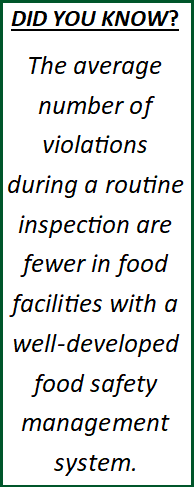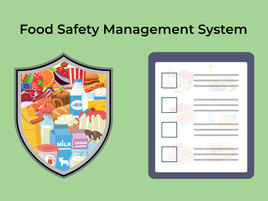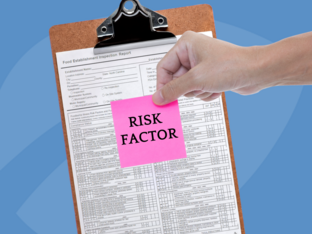|
A food safety newsletter brought to you by
Union County Environmental Health |
|
|
Food safety risk factors are specific activities with a high risk of causing food-borne illness. These risk factors include:
- Poor personal hygiene.
- Improper food holding/time and temperature.
- Contaminated equipment/protection from contamination.
- Inadequate cooking/reheating.
Every food service establishment should have a plan that addresses how to keep food safe during high-risk activities. This type of plan is called a food safety management system.
 |
|
High-risk activities will be different in each establishment due to the menu and processes occurring in the facility. The first step in developing a food safety management system is identifying specific activities that could cause food to become unsafe. Some common high-risk activities are:
- Cooling
- Cooking
- Reheating
- Hand washing/glove use
- Time/temperature control
- Date marking/timely disposal of expired products
- Cross-contamination
- Cleaning/sanitizing
|

After identifying the high-risk activities in your establishment, you should document how to handle these activities in a written plan. The plan should include:
1) Specific procedures for each high-risk activity.
2) Employee training during high-risk activities.
3) Monitoring employees during high-risk activities.
|
Tips for Keeping Food Safe During High-Risk Activities
Cool Hot Food Quickly
- Divide hot food into smaller portions using shallow, metal pans within 30 minutes after cooking/heating.
- Place metal pans into an ice bath on the counter and stir periodically, or move pans into a freezer (loosely covered).
- Verify that the internal temperature of cooling food has dropped to 70°F or below within two hours.
- Leave food in shallow pans and move it into a walk-in cooler or another long-term storage cooler to continue cooling.
- Leave containers loosely covered until the product reaches 41°F or below.
- Avoid stacking multiple containers of cooling food on top of each other.
Cook Raw Animal Foods Thoroughly
- Raw seafood/Raw shell eggs: 145°F
- Raw whole beef/Raw pork: 145°F
- Raw ground meat: 155°F
- Raw poultry (chicken, turkey, duck): 165°F
Reheat Rapidly
- Reheat left-over food to 165°F within two hours.
- Reheat commercially packaged, precooked food to 135°F within two hours.
- Use only equipment designed for reheating.
- Stir food during reheating to distribute heat evenly.
Time/Temperature Control
- Food displayed or stored hot must be held at 135°F or above until served.
- Verify hot food is 135°F or above before placing it into hot holding units.
- Food requiring refrigeration must be held at 41°F or below.
- Monitor refrigeration units by checking internal food temperatures periodically, especially first thing in the morning.
- Cold food that has risen above 41°F during preparation (e.g., lettuce, sliced tomatoes) must be cooled to 41°F or below before placing into prep top coolers.
- Use approved time-holding procedure for foods with a history of not maintaining required hot/cold holding temperatures.

Wash Hands/Use Single-Use Gloves Properly
- Wash hands when they become soiled or contaminated.
- Wash hands before beginning a different task (e.g., between working at the cash register and resuming food preparation).
- Wash hands before putting on single-use gloves.
- Remove single-use gloves and wash hands before beginning a different task (e.g., between working with raw animal foods and working with vegetables).
|
Date Marking/Timely Disposal of Expired Products
- Properly date mark refrigerated, ready-to-eat foods held under refrigeration for more than 24 hours with the preparation/package opening date or with day seven discard date.
- The preparation/package opening date is counted as day one.
- Discard ready-to-eat foods within seven days of preparation/package opening date.
Cross-Contamination
- Clean and sanitize food preparation tables/sinks before and after preparing different types of raw animal foods.
- Use separate food preparation tables to prepare raw animal foods and ready-to-eat foods or prepare them at different times.
- Designate color-coded cutting boards and tongs for each type of raw animal food.
Cleaning/Sanitizing
- Clean and sanitize food contact surfaces and utensils every four hours by washing, rinsing and sanitizing at a three-compartment sink or running through a dish machine.
- Provide proper sanitizer strength in wiping cloth sanitizer buckets and in spray bottles.
- Every day, check the strength of the dish machine's chlorine sanitizer using a chlorine test strip to ensure it falls within the 50-200 ppm range before use.
- Ensure that the hot water sanitizing machine reaches a minimum of 160°F at the surface of the dishes by running a maximum registering thermometer inside.
|
|
|
|